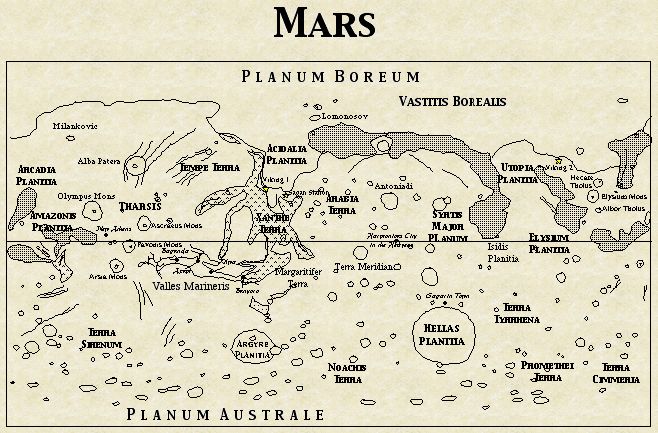Mars
Moons Deimos & Phobos
Politically, the Solar System is considered part of Terra and is under the jurisdiction of Terrad. Both Luna and Mars, populated worlds in their own right, are overshadowed by their more powerful and famous sibling.
(from My Favorite Martians by Jacob Matthews, Alee Publishing, 2068)
Sagan Station, in northern Xanthe, is the oldest continuous settlement on Mars. Primarily a research base, the station is built to support a crew of 150. In recent decades that population has fallen to a scant three dozen dedicated scientists and their families. Largely abandoned by its sponsor, the North American government, Sagan Station is currently supported by the other settlements on Mars. Among Martian teenagers, an overnight visit to Sagan Station is considered something of a rite of passage.
Harmonious City in the Heavens is located on the Martian equator in Meridian. A bustling city of over twenty thousand, Harm City (as it is locally known) is legally part of Outer China and was primarily settled by transportees from all over the Three Chinas. In theory, travel to Harm City is restricted; in practice, the restriction is enforced only on off-planet vessels. Native Martians visit freely, and some have even settled in the city. Both the European Union and Umoja maintain embassies in Harm City. Harm City dedicated its twelfth dome, another agricultural dome, in 2064. With the resultant increase in rice production, Harm City has started exporting rice to other Martian settlements.
Gagarin Town in the north of Hellas is a European city of about eight thousand. Until completion of the Deimos Automated Factory Platform in 2036, Gagarin Town was the manufacturing center of Mars. After the arrival of the fusion drive in 2042, Gagarin Town underwent a renaissance fueled by tourism, primarily from Earth. La Maison Rouge, widely acknowledged to be the best restaurant on Mars, usually has a waiting list tendays long.
The Cities of the Valley, the four largest cities on Mars, are located along the Valles Marineris. In order from west to east, they are: Bagunda, Axum, Kilwa, and Bunyoro. Settled from Africa and politically part of Umoja, these four cities and their associated minor settlements house the majority of the Martian population. Each was a relatively small village until 2042, when the discovery of the fusion drive made emigration to Mars much more economical. In the past 24 years, the Cities of the Valley have expanded tremendously: they are now home to over 150,000 people (a population that is rising steadily). Lavish use of fusion power revolutionized construction on Mars. Instead of the domes and caverns of other cities, the Cities of the Valley are relatively open: strong nanofilm barriers across large sections of the Mariner Valley contain atmosphere and heat and provide effective radiation shielding. A network of high-speed trains connects all four cities in the Valley.
The University of Axum is the nexus of an academic and research community on the cutting edge of high-energy physics, nanomanufacturing, and biotech. The Bunyoro Symphony regularly tours across Mars.
New Athens Located in Tharsis and founded by the legendary Miranda Maris, New Athens is permanent home to 200-250 artists, entertainers, and intellectuals, and temporary home to hundreds more. It is the entertainment capital of Mars, and a popular site for tourists. Entirely contained within one domed crater, New Athens' terraced balconies and constantly-changing holograms are familiar throughout the Solar System. Regular shuttle service to Bagunda, Harm City, and Gagarin Town links New Athens to the rest of Mars.
Politically, New Athens is a free city under Nexus administration. As such, it is often the site of interplanetary and international conferences.

